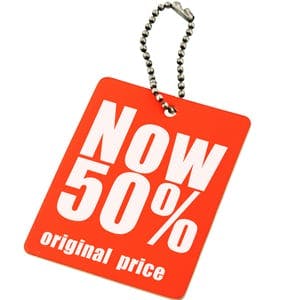Thanks to increasing economic pressure consumers are spending less money, so should you drop prices to sell more products? Raise prices to increase your margins? To help you solve this problem, Thomas Mahon takes a look at the theory behind pricing and value.
Marketing theory tells us that when you’re at par on price with competitors, your customer’s attention will divert to quality. Similarly, if the quality difference is indecipherable between you and your competitors, your customers will be more concerned about your price. A certain quality and a given price equates to your businesses total value… and your total value versus your competitors total value will determine where your customers shop.
But what happens when your customers stop shopping because they have less cash? You drop the price, your value equation improves, and customers will flow, right? It’s a tough call.
What does a %off sign say to customers when it sits on the shelf for 2, 3 or 4 weeks? ‘How much money are you making if you can ‘afford’ to halve all your prices’ the customer might ask themselves, or ‘Is the quality as good as I first thought?’ Will the customer you win with a %off sale ever buy again at full price, knowing full well that you’ll probably discount again?
The simplest articulation of the marketing value equation is: You either offer less, average or more. And you sell it for less, average or more – and this can be said for just about any industry. [Please note, some prefer to use less, same or more]. NQR are an example of a less for less offering. Thomas Dux on the other hand offers more for more. Many businesses like to claim that they can offer more for less, but the best that most achieve is actually average for less… And even this is no mean feat.
What about in tougher times?
Even though we’ve managed to dodge the worst of the GFC, a huge number of other compacting factors including [but not limited to] the Aussie dollar, international competitors ‘moving in’, small businesses grasping the basics of digital marketing and ‘winning’ a much greater share of online wallets, the sheer proliferation of online commerce and the ease of price comparison, have all layered up to create a very sensitive business environment. And this environment is having an enormous impact on what organisations are doing with their value equations.
Some were positioned well for the economic downturn. Some were not. Most though, regardless of how they were positioned beforehand, have made dramatic moves in the face of tougher times.
To ‘the customers’ delight we’ve had almost every major retail scream something about ‘deep discounts’ or ‘great quality, great price’ or the supposedly trust-building option ‘lowest price every day’. In most cases this is essentially an average for less market positioning. Whilst the advertising of these propositions is inevitably monotonous, many businesses have actually been delivering the goods! Organisations have taken their operations back to basics… Reduced product/service depth, streamlined processes, improved sourcing and logistics, and often been able to make genuine price reductions without jeopardising quality.
What has me thinking though is what impact all this repositioning might have on these businesses in the long term? In a world where the major Aussie supermarkets are claiming value equation ‘wins’ with 12c savings on family chickens, who will actually win the customers in the long term?
Win on price, lose on price.
I agree with Harry Beckwith. In his masterful book The Invisible Touch: The Four Keys to Modern Marketing, Beckwith wrote ‘You cannot build relationships with buyers shopping on just price. As soon as someone else offers a lower price, they will be gone…’
Even in tougher times, customers see more than just price – they see value and they crave experiences. Businesses that are able to tough it out without dropping their pants on price to win customers will most likely come off better. And those that were positioned for tougher times all along (or that have genuinely improved their ‘overall value’) will undoubtedly be the biggest winners in years to come.
Dropping prices is not always the best way to win customers; even when it would seem that they’ll come for nothing other than a red hot price. Customers want relationships, dependability and loyalty as much as businesses do. As we all know, a relationship is about commitment, trust and ultimately fulfilment… Particularly when times are tough!
Charge what you’re worth, constantly demonstrate the value of the relationship you offer and keep customers forever.

